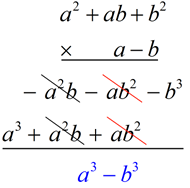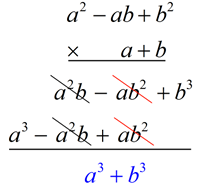In Algebra 1, you worked with factoring the difference of two perfect squares.
a2 - b2 = (a - b)(a + b)
 The sum of two perfect squares, a2 + b2, does not factor under Real numbers. The sum of two perfect squares, a2 + b2, does not factor under Real numbers. |

In Algebra 2, we will extend our factoring skills
to
factoring BOTH the difference and the sum of two perfect CUBES.
Factor the Difference of Perfect Cubes: |
a3 - b3 = (a - b)(a2 + ab + b2)
|
Factor the Sum of Perfect Cubes: |
a3 + b3 = (a + b)(a2 - ab + b2)
|
Let's see that these formulas are actually true.

There is a pattern to the "signs" in the factored form.
Remember
the
Factored Pattern:
 |
• the first binomial term keeps the same sign as the sign between the perfect cubes.
• the sign separating the first and second terms of the trinomial is opposite the sign between the perfect cubes
• the last sign in the trinomial is always positive.

(Note that each formula has only one negative sign in the solution.) |
If all else fails, you can find the factored trinomial by using long division.
One more idea for remembering these patterns:
If you remember one of the patterns,
you can obtain the other pattern by substituting "-b" in place of "b" in your known pattern.
For example, if you know:
a3 + b3 = (a + b)(a2 - ab + b2)
Replace b with -b:
a3 + (-b)3 = (a + (-b))(a2 - a(-b) + (-b)2)
and you have: a3 - b3 = (a - b)(a2 + ab + b2)

Let's look at how the "terms" are related.
When working with perfect cubes look for:
perfect cube numerical values: 8, 27, 64, 125,
216, 343, 512, ...
powers for perfect cube algebraic values:  |
Notice the placement of the "x" and the "numerical entries".
DIFFERENCE of Perfect Cubes:
Factor: x3 - 125
= (x - 5)(x2 + 5x + 25)
= (x - 5)(x2 + 5x + 52) |
Factor: x3 - 343
= (x - 7)(x2 + 7x + 49)
= (x - 7)(x2 + 7x + 72) |
Factor: x3 - a3
= (x - a)(x2 + ax + a2)
|
SUM of Perfect Cubes:
Factor: x3 + 125
= (x + 5)(x2 - 5x + 25)
= (x + 5)(x2 - 5x + 52) |
Factor: x3 + 343
= (x + 7)(x2 - 7x + 49)
= (x + 7)(x2 - 7x + 72) |
Factor: x3 + a3
= (x + a)(x2 - ax + a2)
|
This pattern will be helpful when trying to identify whether an expression
might be the quadratic trinomial component of a perfect cube.

|
Factor: 8x3 - 27 |
Is this expression the difference of perfect cubes?
Look for perfect cubes and appropriate powers.
8x3 and 27 are perfect cubes: 8x3 = (2x)3 and 27 = 33
So, yes, this is the difference of perfect cubes.
|
(2x)3 - 33
a = 2x, b = 3 |
Use formula: a3 - b3 = (a - b)(a2 + ab + b2).
Be sure to use parentheses to avoid problems. |
(2x - 3)((2x)2 + (2x)(3) + 32) |
Remove the inner parentheses on the trinomial expression. This is your factored answer. |
(2x - 3)(4x2 + 6x + 9) |

|
Factor: 64x9 + 125 |
64x9 = (4x3)3 and
125 = 53
This expression is the sum of perfect cubes. |
(4x3)3 + 53 |
a = 4x3 and b = 5
formula:
a3 + b3 = (a + b)(a2 - ab + b2) |
(4x3 + 5)((4x3)2 - (4x3)(5)+ 52) |
Simplify the trinomial to get the factored form. |
(4x3 + 5)(16x6- 20x3+ 25)
|
|
Factor: 56m3 - 7n3 |
At first glance, this may not look like the difference of perfect cubes. BUT, if we factor out the common factor of 7, we will find a hidden difference of perfect cubes. |
7(8m3 - n3) |
a = 2m and b = n
Use formula: a3 - b3 = (a - b)(a2 + ab + b2). |
7(2m - n)((4m)2 + 2mn + n2) |
Solution: |
7(2m - n)(4m2 + 2mn + n2)
|

There is also an observable pattern to "cubing binomials":
Remember: (x + a)3 is NOT (x3 + a3)
(x + a)3 = (x + a) • (x + a) • (x + a)
Cubing a binomial: |
(x + a)3 = x3 + 3ax2 +3a2x + a3
|
You can obtain this next pattern by substituting "-a" for "a": |
(x - a)3 = x3 - 3ax2 +3a2x - a3
|
When you work with the Binomial Theorem, you will get a better understanding
of this pattern of the coefficients in these formulas.
Remember: you can always find these patterns by simply multiplying
(x + a)3 = (x + a)(x + a)( x + a)
(x - a)3 = (x - a)(x - a)( x - a)



